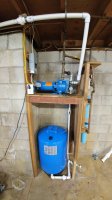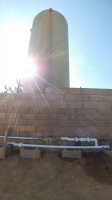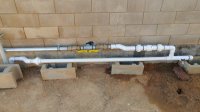JohnnyAirtime
New Member
Good day...
Came upon this site, doing some research and getting conflicting results. Seems everyone here has a similar mindset and are experienced in the issue I'm having.
Here's what I have;
A deep well (500ft), that pumps water up to a 20K gal storage tank. No float valve on the tank, so I manually turn on the well pump via a circuit breaker until the tank overflows. I bought the house with it setup like this... it works. A PITA sometimes (like when I don't see/hear it overflowing!), but it works.
The storage tank, gravity feeds water to my basement (yup, I have a basement in San Diego, CA!) via a 1.5" line. In the basement, is the Goulds shallow well pump (jet pump) that is being used as a booster. about 4ft before the pump, in the suction or supply line to the pump is my check valve. On the output side of the pump, it T's off and supplies pressure to several lines and a 40gal pressure tank (the pressure tank is set a few lbs less then my turn-on pressure switch).
I used to get water hammer in the output side of the pump in the house's pipes when the pump turned on. I had to do some re-piping (due to drips, and poor plumbing practices - which drove me nuts) and at the time replaced my check valve (the check valve was located in it's same spot when I bought the house, I didn't move it - just replaced it as it seemed faulty when I removed and checked it) and my pressure tank (due to the bladder being compromised). The pump "ON" water hammer is gone and hasn't come back since my repairs. Not too long after those repairs, I got water hammer at pump "OFF".
The check valve I used, is a spring operated unit from good 'ol Home Depot. Not sure if it's adequate, so I'm open to options if you all deem it "not worthy" of handling the pump off, and it possibly slamming shut, causing my hammer(?).
Now that you know my setup and what I got from the original homeowner, and what I've since done to the line. Pretty basic. Let's continue...
In my reading, a pump manufacturer suggested the check valve be as close to the water supply as possible. In this case, I'd be putting a check valve just off my storage tank about 200 ft. away. In doing so, it said that will keep my pump from starving or cavitating. Which I don't think it's doing with the check valve only 4 ft away from the pump's inlet, but again... I'm hopeful if I move the check valve, the water hammer will go away? But in doing so, I'm now pressurizing the entire run of pipe back to the storage tank... correct? Not worried about it, just not sure it's what the pump wants (I don't speak "pump" language). Hence one of the many reasons I'm here.
So... the questions are;
I'm all ears. Please enlighten me before I go nuts trying to cure this hammer issue.

Came upon this site, doing some research and getting conflicting results. Seems everyone here has a similar mindset and are experienced in the issue I'm having.
Here's what I have;
A deep well (500ft), that pumps water up to a 20K gal storage tank. No float valve on the tank, so I manually turn on the well pump via a circuit breaker until the tank overflows. I bought the house with it setup like this... it works. A PITA sometimes (like when I don't see/hear it overflowing!), but it works.
The storage tank, gravity feeds water to my basement (yup, I have a basement in San Diego, CA!) via a 1.5" line. In the basement, is the Goulds shallow well pump (jet pump) that is being used as a booster. about 4ft before the pump, in the suction or supply line to the pump is my check valve. On the output side of the pump, it T's off and supplies pressure to several lines and a 40gal pressure tank (the pressure tank is set a few lbs less then my turn-on pressure switch).
I used to get water hammer in the output side of the pump in the house's pipes when the pump turned on. I had to do some re-piping (due to drips, and poor plumbing practices - which drove me nuts) and at the time replaced my check valve (the check valve was located in it's same spot when I bought the house, I didn't move it - just replaced it as it seemed faulty when I removed and checked it) and my pressure tank (due to the bladder being compromised). The pump "ON" water hammer is gone and hasn't come back since my repairs. Not too long after those repairs, I got water hammer at pump "OFF".
The check valve I used, is a spring operated unit from good 'ol Home Depot. Not sure if it's adequate, so I'm open to options if you all deem it "not worthy" of handling the pump off, and it possibly slamming shut, causing my hammer(?).
Now that you know my setup and what I got from the original homeowner, and what I've since done to the line. Pretty basic. Let's continue...
In my reading, a pump manufacturer suggested the check valve be as close to the water supply as possible. In this case, I'd be putting a check valve just off my storage tank about 200 ft. away. In doing so, it said that will keep my pump from starving or cavitating. Which I don't think it's doing with the check valve only 4 ft away from the pump's inlet, but again... I'm hopeful if I move the check valve, the water hammer will go away? But in doing so, I'm now pressurizing the entire run of pipe back to the storage tank... correct? Not worried about it, just not sure it's what the pump wants (I don't speak "pump" language). Hence one of the many reasons I'm here.
So... the questions are;
1. Do I need to upgrade to a better check valve? If yes, please recommend one!
2. Do I move the check valve, from 4 ft away from the pump to 150 ft. away at the water source (storage tank)? Or will this just move my water hammer issue, from within my basement (+/- 50ft of pipe) to now the entire length of pipe 150-200 ft away?!
3. I've read a lot about CSVs (Cycle Stop Valves), and they're just damn confusing. But I can see how they work. Not sure it'd be helpful in my case, as I see most use them for well pumps/pressure tank setups. Not where a "booster" pump is being used. Am I wrong, or would it be beneficial?
4. Should I be making my own arrestor? By T'ing off AT the actual input of the pump, and creating a water/air trap with 12" of vertical 'capped' pipe? I know how plumbers do it in wall for hot/cold at the shower, and I thought about the same concept but in 1-1/4" PVC (the input size of my pump). Seems that's a band-aid, and may/may not work anyway.
If none of this makes sense, I can draw up a picture/sketch.... but, that might be just as confusing. I'd have to use Visio or something to make it look professional (per my OCD).3. I've read a lot about CSVs (Cycle Stop Valves), and they're just damn confusing. But I can see how they work. Not sure it'd be helpful in my case, as I see most use them for well pumps/pressure tank setups. Not where a "booster" pump is being used. Am I wrong, or would it be beneficial?
4. Should I be making my own arrestor? By T'ing off AT the actual input of the pump, and creating a water/air trap with 12" of vertical 'capped' pipe? I know how plumbers do it in wall for hot/cold at the shower, and I thought about the same concept but in 1-1/4" PVC (the input size of my pump). Seems that's a band-aid, and may/may not work anyway.
I'm all ears. Please enlighten me before I go nuts trying to cure this hammer issue.



